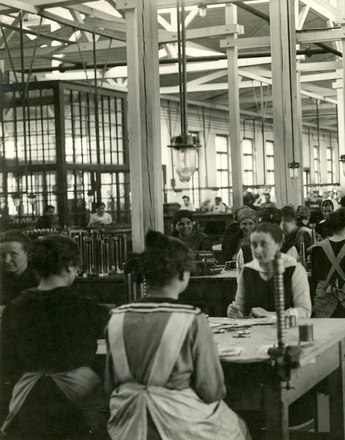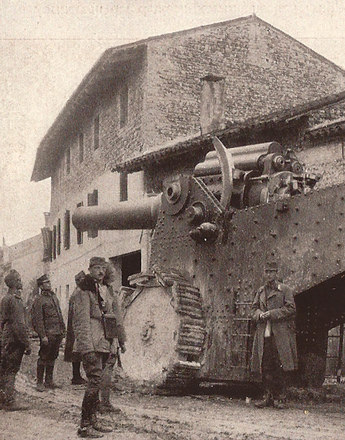The demands of modern warfare went far beyond the production of arms and ammunition. Transport – locomotives, wagons, motor vehicles and even aeroplanes – were of great importance. They were made by Viennese companies like Gräf & Stift and Lohner-Werke.
Apart from the production of armaments, modern warfare called for rapid transport and communication over long distances, a demand that was urgently felt from the very outset. To that extent, it was useful for the military commanders that the largest locomotive and wagon factories in the monarchy were in Vienna and Lower Austria, in particular Maschinenfabrik der Staatseisenbahngesellschaft and Florisdorfer Lokomotivfabrik, as well as important repair works in the 10th, 11th and 21st districts. Wagon production was also significant. In 1918 Maschinen- und Waggonfabrik AG in Simmering employed 1,600 workers. Locomotives were built on a large scale from 1915 thanks to orders from the Ministry of Railways. Output peaked in 1916 and 1917. Towards the end of the war repair contracts accumulated.
Because of surplus production in 1914, the motor factories shifted initially to the manufacture of fillers for grenades, etc. In 1915 and 1916 they concentrated almost exclusively on making automobile engines for the military. In 1917 the demand for engines increased dramatically because of the scarcity of coal, but dropped again in 1918 as fuel shortages made themselves felt.
The Vienna automobile industry experienced a considerable boom during the war. At the start of the war, it shifted to making trucks and lorries for the military. In September 1914 a delivery plan was drawn up with the active involvement of the Viennese vehicle factories. The initial focus was on trucks, along with workshop trolleys and trailers, light railway, aeroplane and boat engines. One of the main suppliers of military vehicles, particularly special vehicles including customised models, was Wiener Automobilfabrik AG (Gräf & Stift) in the 19th district, which in 1915 alone provided 120 auxiliary, seven lighting, six command, three medical and 32 workshop vehicles for the army. Austria’s largest automobile plant was built in 1916–18 in Laxenburgerstrasse in the 10th district by Steyr-Werke. It made engines and bodies.
The aircraft industry also expanded considerably. Lohner-Werke in Floridsdorf built a large double hangar and wood-drying plant. By March 1916 it had invested around 1 million krone. Production was stepped up in this way and through the recruitment of additional workers – including for a time sailors from the Austro-Hungarian navy. From 1 August 1914 to 29 February 1916 Lohner delivered 97 seaplanes and 170 aeroplanes, 81 of them unassembled.
Shortly after the declaration of war, the Viennese electrical engineering industry also received major orders from the military. It required light railways, radio and telegraph equipment, electric vehicles and electrically powered workshops. Maschinenfabrik Condor in the 10th district supplied the Austro-Hungarian army with transportable masts for wireless telegraph communication.
Translation: Nick Somers
Heimatausschuß der Lehrergemeinschaften des XXI. Bezirks: Der XXI. Wiener Gemeindebezirk. Ein Heimatbuch für Schule und Haus, Wien 1926
Keimel, Reinhard: Flugzeuge der österreichischen Firma Lohner 1909-1923 (Sonderheft der Blätter für Technikgeschichte), Wien 1990
Seper, Hans: Österreichische Automobilgeschichte 1815 bis heute, Wien 1986
Seper, Hans: Die Brüder Gräf. Geschichte der Gräf & Stift-Automobile, Wels/München/Kreuzlingen 1991
Weigl, Andreas: Kriegsindustrie. Die Wiener Wirtschaft im Dienst der Kriegsökonomie, in: Pfoser, Alfred/Weigl, Andreas (Hrsg.): Im Epizentrum des Zusammenbruchs. Wien im Ersten Weltkrieg, Wien 2013, 220–231





